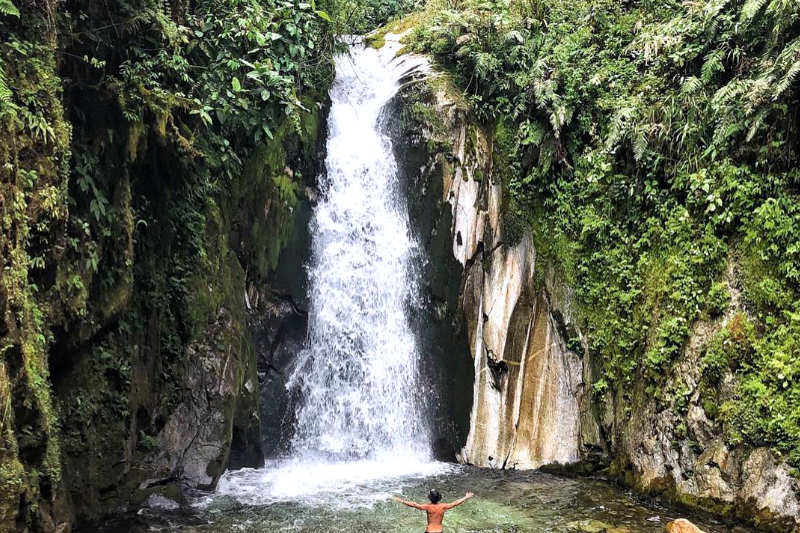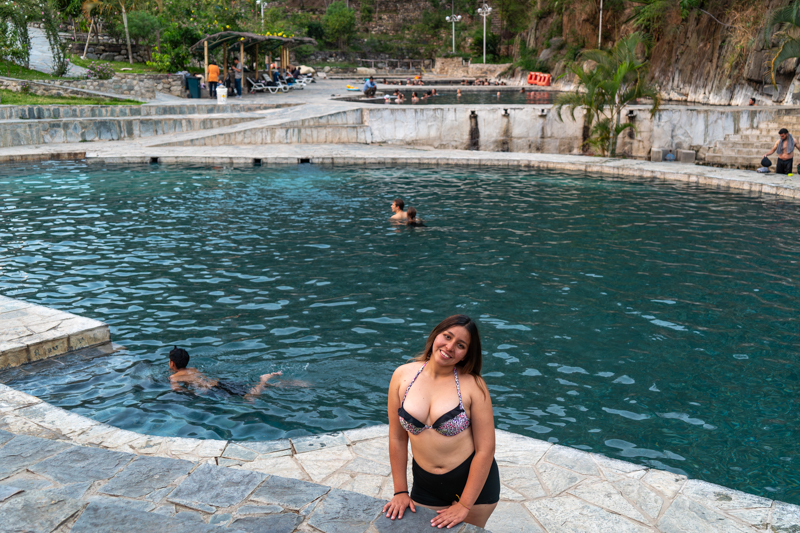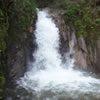Tourist Attractions around Machu Picchu Pueblo
Machu Picchu Pueblo, also called Aguas Calientes, offers a spectacular and wonderful natural landscape of the high jungle of Cusco. It has a geography that shows great biodiversity, ecosystems and natural areas ideal for all those people who like hiking. The ideal way to get to know Machu Picchu Pueblo and its surroundings is to spend 3 nights and take picturesque walks with a broad view of the flora, fauna, geology and history of the place. In addition to Machu Picchu, there are incredible tourist attractions nearby. Get to know them!
- Walk to the Gardens of Mandor
- The butterfly garden of Machu Picchu
- The Putucusi Mountain viewpoint
- The thermal baths of Aguas Calientes
- The thermal baths of Cocalmayo
- The Machupicchu site museum

Mandor Waterfall – Machu Picchu
Machu Picchu, the great tourist attraction of Cusco and Peru
Machu Picchu is located in the district of Aguas Calientes, province of Urubamba in the Cusco region of Peru. Due to its fame and importance, Aguas Calientes is also called Machupicchu town. It is located just 10 kilometers from the Inca archaeological site. The town is a mandatory point since the return trains to the city of Cusco depart from there. It has a special charm and some tourist attractions that are recommended to visit.
Walk to the Gardens of Mandor
- Mandor is a town located at kilometer 114 of the Cusco – Hydroelectric railway line. This means a walk of approximately 1 hour from Machu Picchu town.
- The road is parallel along the banks of the Vilcanota River and enters beautiful places in the humid jungle of Cusco..
- The Mandor Gardens feature a beautiful waterfall approximately 20 meters high. In addition, a geography full of vegetation where, with luck, you can see birds, orchids and even species of local fauna.
- The characteristic flora of the Mandor gardens are: begonias, bromeliads, orchids, various shrubs, ferns, native trees. Also during this walk, you will be accompanied by the songs of the local birds such as hummingbirds, parrots, tarangas, you will be able to see butterflies (more than 400 species) and a complex diversity of mushrooms, of different colors and sizes.
- These places are available to the public all day, but it is recommended to visit them from 6:30 am to 4:30 pm. The cost is 5 soles for Peruvians and 10 soles for foreigners.
The butterfly garden of Machu Picchu
- The Machu Picchu Pueblo butterfly garden is located just 20 minutes from Machu Picchu Pueblo (at Km 112), on the Hiram Bingham Highway (the route that connects Aguas Calientes with Machu Picchu).
- The butterfly garden is also called ‘Wasi Pillpi’, a Quechua word that means ‘Butterfly House’. There you can find more than five hundred species of butterflies, of which 100 belong to the geography of Machu Picchu and another 400 are other species.
- The butterfly farm also has spaces for the conservation and reproduction of butterfly species. Its care and evolution is in all its phases. Some butterflies that are in captivity are released into the wild.
- The butterfly garden offers a sample of the great diversity of butterflies in Machu Picchu. In addition, butterfly interpretation activities are carried out and you can take a guided tour.
- The butterfly garden’s opening hours are Monday to Sunday from 7 in the morning. at 4.30 in the afternoon. Admission costs 10 soles for all tourists.
The Putucusi Mountain viewpoint
- The Putucusi mountain is one of the mountains that surround Machu Picchu. Its name ‘Putucusi’ is a Quechua word that means “Joyful Mountain.”
- It is a circular mountain, located northeast of the Vilcanota River, in the district of Machu Picchu town, province of Urubamba, department of Cusco.
- Putucusi has a height of 2,500 meters above sea level and is the third sacred mountain of Machu Picchu.
- The Putucusi is covered with dense vegetation, with the presence of ferns, alders, pisonay and more than 90 species of orchids. In addition, it stands out for its own jungle fauna. It has an important diversity of butterflies, birds, parrots, a variety of insects, etc.
- The ascent to Putucusi has a high degree of difficulty. The route begins in the town of Aguas Calientes following the train tracks. Then you take a detour up the mountain. You continue ascending along the marked path and in different ways, with small steps. The most dangerous part are stairs made of wood almost 12 meters high, attached to the mountain and with a slope of 80º and 90º.
- The walk lasts approximately 2 hours, depending on the physique of the passenger, given that the walls of the mountain are practically vertical.
- The Putucusi was a place of surveillance and control of the Inca city of Machu Picchu. Getting to the top is quite a challenge. From the top you can see in all its splendor, the Vilcanota canyon, the Machu Picchu mountain and the Huayna Picchu Mountain.
- Once the ascent begins, you will find plenty of vegetation. It is a difficult climb as it requires a lot of physical effort.
- The walk has a high degree of risk and a medium level of difficulty. It is not recommended for people who suffer from vertigo. If you decide to do this hike, you are reminded to be very careful, especially when climbing the wooden stairs to avoid accidents and meet the challenge of reaching the top.

View of Machu Picchu from the top of Putucusi
The thermal baths of Aguas Calientes
- The Aguas Calientes thermal baths are the main tourist attraction of Machupicchu town. They are located in the upper part of the town, at a distance of approximately 400 meters. The walk is only 15 minutes.
- Although the place is small, the thermal baths offer a moment of relaxation after visiting Machu Picchu. The temperatures of its seven water wells vary between 38ºC. and 46ºC.
- The waters are of volcanic origin and have an opaque yellow color, rich in minerals that are beneficial for relaxing muscles and bones, as well as oxygenating the skin.
- The thermal baths have a bar, toilets, showers and more. Office hours are available from 5 in the morning to 8 at night. The cost is 10 soles for Peruvian tourists and 20 soles for foreign tourists.
The thermal baths of Cocalmayo
- The Cocalmayo baths are known for the outcropping of their waters that give them an idyllic, beautiful landscape under the mountains.
- The thermal baths are located on the slopes of a mountain and on the banks of the Urubamba River. It belongs to the district of Santa Teresa, about 30 kilometers from the Inca city of Machu Picchu.
- The waters of these baths come from the underground and are of mineral-medicinal origin with many healing properties. They are located within a place, ideal for resting in the natural environment, where coffee, avocado and passion fruit crops abound.
- Most visitors know the thermal baths within the 5-day Salkantay trek or the 4-day Inca Jungle. However, it is also possible to visit it starting from the town of Aguas Calientes.
- Its three natural pools have temperatures that vary from 38ºC. up to 44ºC. It has clear colored waters.
- The route includes the walk from Aguas Calientes to the Hidroeléctrica station (10 kilometer walking route). Then you take a shuttle to the town of Santa Teresa and, finally, to the thermal baths.
- Visiting hours to the Cocalmayo thermal baths are every day from 6 in the morning to 5 in the afternoon. The cost is 5 soles for Peruvians and 10 soles for foreign tourists.

Cocalmayo Hot Springs
The Machupicchu site museum
- The Machupicchu site museum is called ‘Manuel Chávez Ballón’ in homage to the Cusco researcher who worked at the Inca archaeological site in the mid-20th century.
- The Manuel Chávez Ballón site museum is located on the Hiram Bingham Highway, which leads from Aguas Calientes to Machu Picchu. The walking route takes approximately 30 minutes.
- The site museum has seven sequences with audiovisual material about the discovery and enhancement of Machu Picchu. In addition, there are ceramic, lithic, metallurgical objects and skeletal remains obtained during excavations at Machu Picchu.
- The museum also has a botanical garden with species of flowers that abound in Machu Picchu. Visiting hours at the museum are from 8 in the morning until 4 in the afternoon.
- The price of the visit is 22 Peruvian soles for adults. Admission is free upon presentation of the entrance ticket to Machu Picchu starting at noon.
Advice from people who have been there
 By: Josefina C
By: Josefina C“It was worth it!“
“The trip to Machu Picchu is something that should be done at least once in your life. I did it with this agency on the recommendation of a friend. I don't have any complaints except that I was very tired after the trip. Well, at least the fatigue passed, but the memory of Machu Picchu continues.“
By Ticket Machu Picchu – Last updated, December 27, 2023
